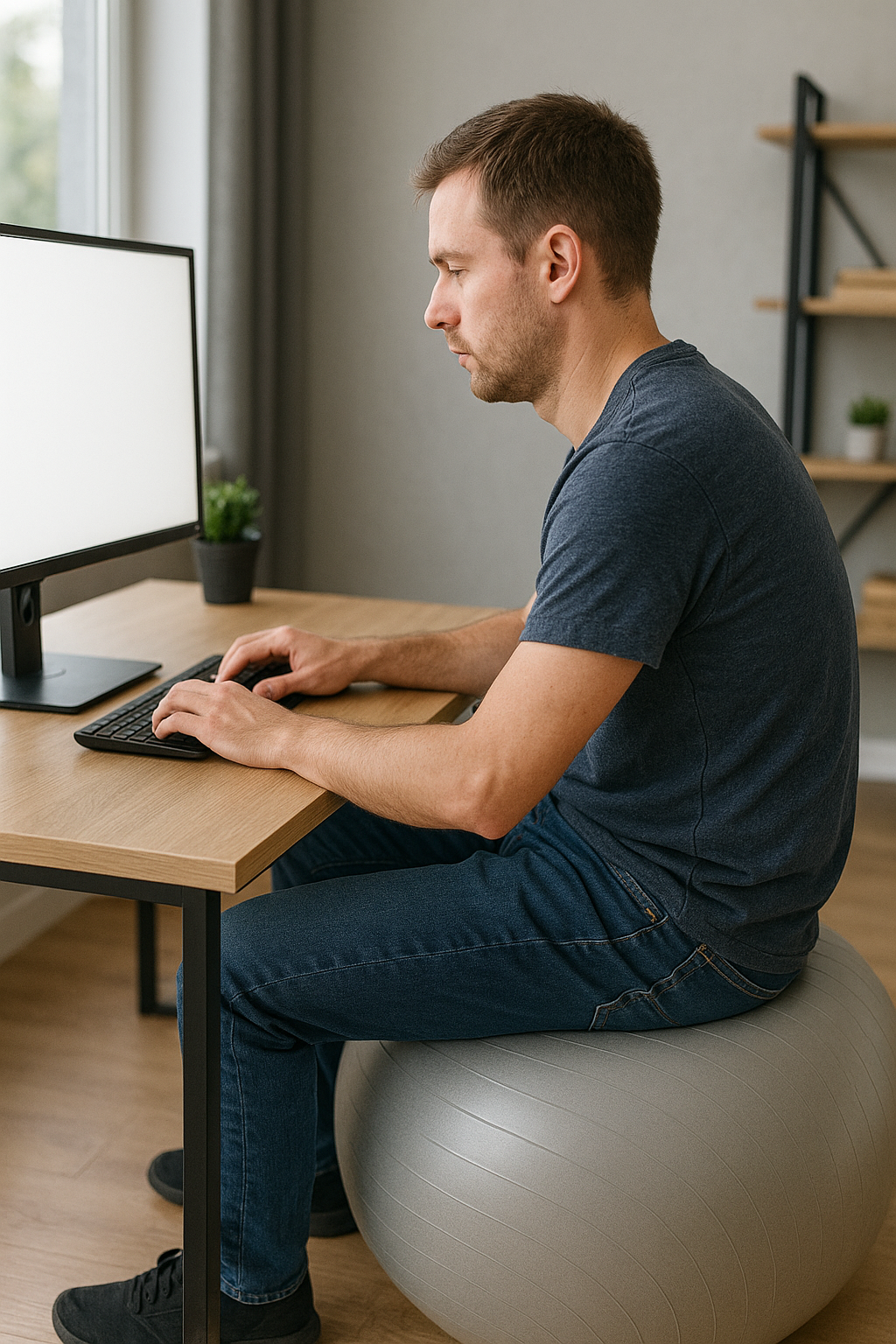 Back pain is one of the most common reasons for people in the UK to seek medical attention or take time off work. In fact, statistics show that approximately 65 to 80 % of the population will experience back pain at some point in their lives. According to Versus Arthritis, 1 in 6 adults have some form of low back pain in England, making it the leading cause of disability in the UK. Modern-day lifestyles often involve prolonged periods of sitting in poor postural positions, which can gradually lead to discomfort over time. Additionally, work-related back pain is common, with incorrect repetitive lifting, sitting in a slumped position, twisting, and bending incorrectly contributing to the risk of musculoskeletal (MSK) injuries. To effectively manage and prevent back pain at work, it’s crucial to recognise the interconnection between our physical and mental health. Employers should implement comprehensive strategies aimed at preventing such ailments, thus addressing these concerns holistically to mitigate the risk of MSK injuries.
Back pain is one of the most common reasons for people in the UK to seek medical attention or take time off work. In fact, statistics show that approximately 65 to 80 % of the population will experience back pain at some point in their lives. According to Versus Arthritis, 1 in 6 adults have some form of low back pain in England, making it the leading cause of disability in the UK. Modern-day lifestyles often involve prolonged periods of sitting in poor postural positions, which can gradually lead to discomfort over time. Additionally, work-related back pain is common, with incorrect repetitive lifting, sitting in a slumped position, twisting, and bending incorrectly contributing to the risk of musculoskeletal (MSK) injuries. To effectively manage and prevent back pain at work, it’s crucial to recognise the interconnection between our physical and mental health. Employers should implement comprehensive strategies aimed at preventing such ailments, thus addressing these concerns holistically to mitigate the risk of MSK injuries.
Understanding the Root Causes of Work-Related Back Pain:
Twisting and Bending Awkwardly
Performing tasks that involve twisting or bending in awkward positions can strain the muscles and ligaments of the back, leading to discomfort and pain. These movements, if repeated frequently or done improperly, can contribute to long-term issues.
Incorrect or Unsafe Lifting Techniques
Lifting objects incorrectly or unsafely places undue stress on the spine and surrounding muscles. Improper lifting techniques can lead to strains, sprains, and even more serious injuries, particularly if done repeatedly over time without proper form or support.
Poor Posture
Maintaining poor posture, especially while seated for extended periods, is a common culprit behind work-related back pain. Even with efforts to maintain good posture, the prolonged sitting characteristic of office work can exert significant pressure on the lumbar discs, exacerbating discomfort and increasing the risk of injury.
Office workers, in particular, are susceptible to back pain due to prolonged periods of sitting. Interestingly, even with ostensibly good posture, sitting still places 40% more pressure on the lumbar discs compared to standing, and unsupported slouched sitting increases this pressure by 80%.Unfortunately, many individuals may not realise the impact of their poor postures and lifting techniques until they experience discomfort or pain, often after years of repetitive strain.
Furthermore, these habits tend to worsen with age, contributing to the higher prevalence of back pain among older individuals. Over time, these accumulated stresses and strains can manifest as chronic pain and associated issues, making it challenging to alleviate the pain or address the underlying causes effectively.
Identifying and addressing the root causes of work-related back pain, such as poor posture and improper lifting techniques, is crucial for preventing long-term discomfort and promoting overall spinal health. By fostering awareness of proper body mechanics and providing resources for ergonomic support, employers can help mitigate the risk of back pain among their workforce, enhancing both productivity and wellbeing.
Self-Care Strategies for Preventing Work-Related Back Pain:
Optimise Your Workspace
Start by ensuring your workstation is ergonomically designed to support your spine and promote good posture. Your chair should offer adequate lumbar support, and your desk should be at the correct height to prevent strain on your neck and shoulders.
Take Regular Breaks and Move More
Sitting for extended periods can lead to stiffness, postural fatigue, and eventual discomfort. Aim to adjust your posture every 20-30 minutes and take regular breaks from your desk every hour. Be active during your breaks to increase circulation, reduce muscle tension and fatigue, and improve concentration. If you’ve noticed a decrease in your daily step count since working from home, consider adding a 20-minute walking ‘commute’ to your desk in the morning and at the end of the day. The human body needs movement to stay supple and flexible, reducing the risk of pain and discomfort.
Core Strengthening and Incorporating Different Exercises
Integrate exercises targeting core muscles into your breaks to act as a natural corset for the body, preserving the spine’s natural curves. Even allocating just 10 minutes a day to core exercises can significantly benefit spine health.
Consider engaging in activities like Pilates or swimming, as they effectively strengthen the core while promoting flexibility and overall spinal health. These exercises serve as valuable additions to your routine during breaks from prolonged sitting, reducing the risk of back pain and discomfort.
Lift Correctly
Practice safe lifting techniques by bending from your knees and hips rather than your back when lifting heavy objects. Keep the object close to your body and avoid twisting while lifting or carrying. If an object is too heavy or awkward to lift alone, seek assistance or use mechanical aids to reduce strain on your back. Prioritise proper body mechanics and lifting ergonomics to minimise the risk of back injuries and maintain spinal health in the workplace.
Manage Stress
Prioritise stress management techniques to alleviate tension and promote overall wellbeing. Incorporate mindfulness practices, deep breathing exercises, or meditation into your daily routine to reduce stress levels. Take regular breaks throughout the day to relax and recharge, and establish boundaries to maintain a healthy work-life balance. By managing stress effectively, you can minimise its impact on your physical health and reduce the likelihood of experiencing back pain.
Maintain a Healthy Diet
Fuel your body with nutritious foods to support optimal spinal health and overall wellness. Focus on consuming a balanced diet rich in fruits, vegetables, lean proteins, and whole grains. Stay hydrated by drinking plenty of water throughout the day, and limit intake of sugary drinks and processed foods. Consider packing nutritious snacks and meals to bring to work, and avoid excessive caffeine and alcohol consumption. By nourishing your body with wholesome foods, you can support your musculoskeletal system and reduce the risk of back pain associated with poor dietary choices.
Implement Effective Sleep Hygiene Practices
Prioritise quality sleep as an essential component of back pain prevention and overall wellbeing. Aim for 7-9 hours of uninterrupted sleep each night, ensuring your sleeping environment is conducive to restorative rest. Invest in a supportive mattress and pillows that promote proper spinal alignment and comfort. Additionally, establish a relaxing bedtime routine to signal to your body that it’s time to unwind, such as dimming the lights, reading a book, or practicing relaxation techniques. Avoid caffeine, heavy meals, and electronic devices close to bedtime, as they can interfere with your ability to fall asleep and stay asleep. By prioritising restorative sleep, you can support your body’s natural healing processes and reduce the risk of experiencing work-related back pain.
Supporting Employees Through Proactive Measures:
Employers play a crucial role in promoting safe and ergonomic working environments to prevent the onset of low back pain among employees. By taking proactive measures, they not only help individuals avoid discomfort but also facilitate their ability to remain productive and engaged in their work. Additionally, employees themselves can take steps to maintain healthy backs. Here are some strategies employers can implement:
Encourage Prompt Reporting of Musculoskeletal Issues
Promote a culture where employees feel comfortable reporting any musculoskeletal discomfort or concerns at an early stage. Encouraging open communication allows for timely intervention and support.
Foster a Culture of Support and Open Communication
Create a supportive work culture where employees feel valued, respected, and empowered to voice their concerns about workplace health and safety. Encourage open communication channels for employees to provide feedback, report issues, and suggest improvements. Implement regular check-ins or surveys to assess employee satisfaction and gather insights into potential areas for improvement. By fostering a culture of support and collaboration, employers can effectively address the root causes of work-related back pain and promote a positive work environment for all employees.
Conduct and Review Risk Assessments
Regularly conduct comprehensive risk assessments to identify and mitigate potential hazards that could contribute to low back pain. Utilise tools such as the MAC (Manual Handling Assessment Charts) and RAPP (Risk Assessment of Pushing and Pulling) to evaluate manual handling tasks involving the back and implement appropriate control measures.
Foster Safe Manual Handling Practices
Emphasise the importance of adhering to safe working practices and manual handling procedures to minimise the risk of injury. Provide employees with suitable equipment and training to perform tasks safely and effectively, reducing strain on the back and other vulnerable areas.
Promote Proper Workstation Setup
Offer DSE (Display Screen Equipment) workstation assessor training and conduct regular DSE workstation assessments to ensure that employees’ workstations are ergonomically optimised. Provide appropriate and adjustable equipment, such as ergonomic chairs, keyboards, and monitor stands to support correct posture and reduce the risk of musculoskeletal discomfort and back pain. Additionally, encourage employees to personalise their workstations according to their individual needs and preferences, fostering a sense of ownership over their workspace.
Provide Access to Health and Wellness Resources
Offer access to resources that promote overall health and wellbeing, including physical activity programs, mental health support services, and nutritional guidance. Encourage participation in workplace wellness initiatives such as yoga classes, mindfulness sessions, or on-site fitness facilities. By prioritising holistic employee health, employers can create a supportive environment that reduces the risk of work-related back pain and enhances overall quality of life.
In conclusion, work-related back pain is a prevalent issue in the workplace, affecting productivity, wellbeing, and overall quality of life for many individuals. However, by understanding the root causes and implementing proactive strategies, employers and employees can collaborate effectively to prevent and manage work-related back pain.
Employers can play a pivotal role in creating safe and ergonomic work environments by conducting risk assessments, promoting safe manual handling practices, and providing access to resources for workstation optimisation and health promotion. By fostering a culture of support, open communication, and prioritising holistic employee wellbeing, employers can empower their workforce to prioritise spinal health and reduce the risk of work-related back pain.
Meanwhile, employees can take proactive steps to support their own spinal health through self-care strategies such as optimising their workspace, incorporating regular movement and core strengthening exercises, lifting correctly, managing stress, and maintaining a healthy diet. By adopting these practices into their daily routines, individuals can reduce the likelihood of experiencing back pain and improve overall spinal health and wellbeing.
Ultimately, by working together and prioritising spinal health in the workplace, employers and employees can create a culture that promotes productivity, engagement, and a healthier, happier workforce.
If you are interested in exploring how our DSE Services can support you and your organisation’s goals, we invite you to get in touch.
Related Articles:
Low Back Pain- Busting the Myths
Ergonomics Unveiled: Navigating the Path to Workplace Wellbeing and Productivity







